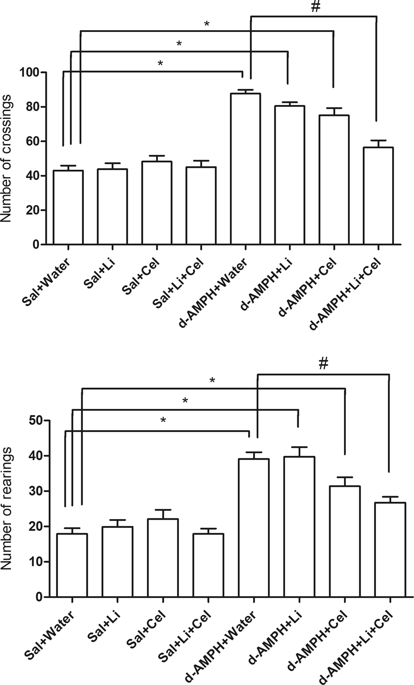当前位置:
X-MOL 学术
›
Transl. Psychiaty
›
论文详情
Our official English website, www.x-mol.net, welcomes your feedback! (Note: you will need to create a separate account there.)
Coadministration of lithium and celecoxib reverses manic-like behavior and decreases oxidative stress in a dopaminergic model of mania induced in rats.
Translational Psychiatry ( IF 6.8 ) Pub Date : 2019-11-13 , DOI: 10.1038/s41398-019-0637-9 Samira S Valvassori 1 , Paula T Tonin 1 , Gustavo C Dal-Pont 1 , Roger B Varela 1 , José Henrique Cararo 1 , Abel Freitas Garcia 1 , Fernanda F Gava 1 , Samira Menegas 1 , Jair C Soares 2 , João Quevedo 1, 2, 3, 4
Translational Psychiatry ( IF 6.8 ) Pub Date : 2019-11-13 , DOI: 10.1038/s41398-019-0637-9 Samira S Valvassori 1 , Paula T Tonin 1 , Gustavo C Dal-Pont 1 , Roger B Varela 1 , José Henrique Cararo 1 , Abel Freitas Garcia 1 , Fernanda F Gava 1 , Samira Menegas 1 , Jair C Soares 2 , João Quevedo 1, 2, 3, 4
Affiliation

|
The present study intends to investigate the effect of lithium (Li) and celecoxib (Cel) coadministration on the behavioral status and oxidative stress parameters in a rat model of mania induced by dextroamphetamine (d-AMPH). Male Wistar rats were treated with d-AMPH or saline (Sal) for 14 days; on the 8th day of treatment, rats received lithium (Li), celecoxib (Cel), Li plus Cel, or water until day 14. Levels of oxidative stress parameters were evaluated in the serum, frontal cortex, and hippocampus. d-AMPH administration induced hyperlocomotion in rats, which was significantly reversed by Li and Cel coadministration. In addition, d-AMPH administration induced damage to proteins and lipids in the frontal cortex and hippocampus of rats. All these impairments were reversed by treatment with Li and/or Cel, in a way dependent on cerebral area and biochemical analysis. Li and Cel coadministration reversed the d-AMPH-induced decrease in catalase activity in cerebral structures. The activity of glutathione peroxidase was decreased in the frontal cortex of animals receiving d-AMPH, and treatment with Li, Cel, or a combination thereof reversed this alteration in this structure. Overall, data indicate hyperlocomotion and alteration in oxidative stress biomarkers in the cerebral structures of rats receiving d-AMPH. Li and Cel coadministration can mitigate these modifications, comprising a potential novel approach for BD therapy.
中文翻译:

在大鼠引起的躁狂症的多巴胺能模型中,锂和塞来昔布的共同给药可逆转躁狂样行为并降低氧化应激。
本研究旨在探讨锂(Li)和塞来昔布(Cel)共同给药对右旋苯丙胺(d-AMPH)引起的躁狂症大鼠行为状态和氧化应激参数的影响。将雄性Wistar大鼠用d-AMPH或生理盐水(Sal)处理14天;在治疗的第8天,大鼠接受锂(Li),塞来昔布(Cel),锂加Cel或水直到第14天。评估血清,额叶皮层和海马中氧化应激参数的水平。d-AMPH给药引起大鼠运动过度,Li和Cel共同给药可明显逆转。此外,d-AMPH给药可引起大鼠额叶皮层和海马中蛋白质和脂质的损伤。通过使用Li和/或Cel进行治疗,可以逆转所有这些损伤,在某种程度上取决于大脑区域和生化分析。Li和Cel的共同给药逆转了d-AMPH诱导的大脑结构中过氧化氢酶活性的下降。在接受d-AMPH的动物的额叶皮质中,谷胱甘肽过氧化物酶的活性降低,用Li,Cel或它们的组合治疗逆转了这种结构的改变。总体而言,数据表明接受d-AMPH的大鼠大脑结构中的超运动和氧化应激生物标志物的改变。Li和Cel的共同给药可以减轻这些改变,包括用于BD治疗的潜在的新方法。用Li,Cel或其组合的处理逆转了这种结构的改变。总体而言,数据表明接受d-AMPH的大鼠大脑结构中的超运动和氧化应激生物标志物的改变。Li和Cel的共同给药可以减轻这些改变,包括用于BD治疗的潜在的新方法。用Li,Cel或其组合的处理逆转了这种结构的改变。总体而言,数据表明接受d-AMPH的大鼠大脑结构中的超运动和氧化应激生物标志物的改变。Li和Cel的共同给药可以减轻这些改变,包括用于BD治疗的潜在的新方法。
更新日期:2019-11-13
中文翻译:

在大鼠引起的躁狂症的多巴胺能模型中,锂和塞来昔布的共同给药可逆转躁狂样行为并降低氧化应激。
本研究旨在探讨锂(Li)和塞来昔布(Cel)共同给药对右旋苯丙胺(d-AMPH)引起的躁狂症大鼠行为状态和氧化应激参数的影响。将雄性Wistar大鼠用d-AMPH或生理盐水(Sal)处理14天;在治疗的第8天,大鼠接受锂(Li),塞来昔布(Cel),锂加Cel或水直到第14天。评估血清,额叶皮层和海马中氧化应激参数的水平。d-AMPH给药引起大鼠运动过度,Li和Cel共同给药可明显逆转。此外,d-AMPH给药可引起大鼠额叶皮层和海马中蛋白质和脂质的损伤。通过使用Li和/或Cel进行治疗,可以逆转所有这些损伤,在某种程度上取决于大脑区域和生化分析。Li和Cel的共同给药逆转了d-AMPH诱导的大脑结构中过氧化氢酶活性的下降。在接受d-AMPH的动物的额叶皮质中,谷胱甘肽过氧化物酶的活性降低,用Li,Cel或它们的组合治疗逆转了这种结构的改变。总体而言,数据表明接受d-AMPH的大鼠大脑结构中的超运动和氧化应激生物标志物的改变。Li和Cel的共同给药可以减轻这些改变,包括用于BD治疗的潜在的新方法。用Li,Cel或其组合的处理逆转了这种结构的改变。总体而言,数据表明接受d-AMPH的大鼠大脑结构中的超运动和氧化应激生物标志物的改变。Li和Cel的共同给药可以减轻这些改变,包括用于BD治疗的潜在的新方法。用Li,Cel或其组合的处理逆转了这种结构的改变。总体而言,数据表明接受d-AMPH的大鼠大脑结构中的超运动和氧化应激生物标志物的改变。Li和Cel的共同给药可以减轻这些改变,包括用于BD治疗的潜在的新方法。



























 京公网安备 11010802027423号
京公网安备 11010802027423号